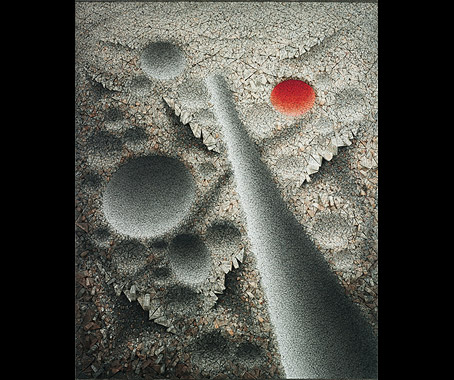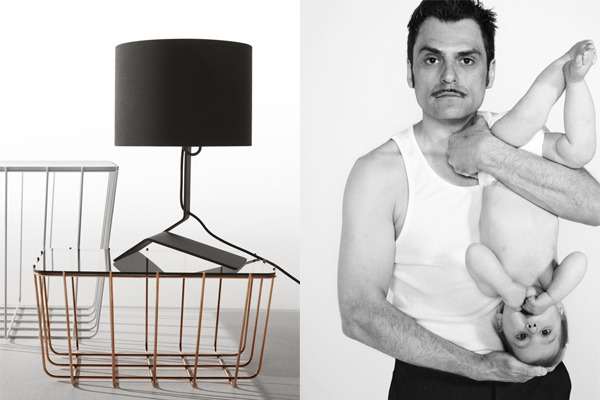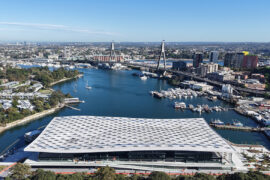Korean artist Chun Kwang Young tells Yvonne Xu what his paper-wrapped art, which he calls Aggregations, amounts to.

indesignlive.sg
May 30th, 2013
When I went to see Chun Kwang Young’s work at the Art Plural Gallery in Singapore, the artist invited me to commit the faux pas – touch the artwork in the gallery. I ventured to do so carefully on one of hundreds of paper-wrapped triangular wedges that are jutting out of what is, up close, a busy and closely packed canvas. “Now,” Chun said, “This paper has your fingerprint, it is your fingerprint, no one else’s. This paper is 70 years old, 80, 90, maybe 100 years old – think about it, there are many different people who have touched it, maybe a lady, maybe a man, maybe poor, maybe rich, maybe a teacher and a student…”

Chun, known for a unique technique of assembling foam triangles wrapped in mulberry paper into sculptural relief pieces, was trying to explain his fascination with his material of choice – old mulberry paper.
“This paper has the spirit and soul of Koreans, so many stories, so many histories,” Chun said. The spirit and soul of an unimaginable number of people (the books’ makers, authors, sellers, readers, and now including, perhaps, the journalists who have been invited to lay their invisible imprint) is a wonder to the artist. “I want to wrap all these stories and histories, and present it from the heart.” He calls these works Aggregations.

Mulberry paper is traditionally used in Korea to wrap medicine and food and is ubiquitously found in Korean households. When Chun returned to Korea after more than ten years of studying and working in the West to look for his roots and also a personal history to create art from, he rediscovered the material resonated deeply with him.
“I think the thing I first saw [as a child] was my mother’s face, and the second thing must be mulberry paper,” he shared. He said he holds vivid memories of him as a child looking up at wrapped bundles of medicine in his grandfather’s herbal-scented Chinese medicine hall.

For the past 19 years, Chun has been collecting old books for their paper. He paints them with natural vegetable dyes distilled in vats of boiling water in his studio before tying them into bundled wedges for their assembly on wooden canvasses. “People always ask me what is inside. The hardware is foam and paper, but how can it just be that?” Chun’s work is surely light as foam and paper, but heavy with meaning.

When asked about the imagery of his work (many people have thought the reliefs were lunar or meteorite-like), or the message he wishes to convey in his work (said to be metaphors of our modern society, devastated by the destruction of our environment, capitalism and endless conflict), Chun said he preferred to leave the reading to the viewer but he did offer a clue.
“For an artist two plus two is not four, it can be six, eight, anything. If you take away the triangles, you will see I have a lot of drawings under them. Sometimes, I put in a joke! And this one,” Chun said, referring to one of the 22 pieces on show at the gallery now, “I was dreaming about the night sky with stars… the other one, maybe [a] different story. I dream and I swim, that’s what an artist does, there is no plan. It can be a little messed up, two plus two is anything, you are free as an artist.”

Standing before any of Chun’s piece, the power of an aggregation or an accumulation is strongly felt, but there is also a sense of minutiae, of a smallness like that of the bundled triangle, or of a printed character on paper. There is sense of collective history, yet also of smaller, personal stories. As to what the collage amounts to, there seem to be no defined answers – like text on the paper, they are folded away, unfinished, unknowable or even unseen, like invisible fingerprints. One starts to understand that in Chun’s artistic aggregations, two plus two truly isn’t a standard four, it is much more than that.
Chun has received numerous awards and accolades including artist of the year by The National Museum of Contemporary Art, Seoul in 2001. His works can be found in many prestigious museums, including UK’s Victoria & Albert Museum.
His solo exhibition Assemblage is now on at Art Plural Gallery till 27 July 2013.
Images courtesy of Art Plural Gallery
INDESIGN is on instagram
Follow @indesignlive
A searchable and comprehensive guide for specifying leading products and their suppliers
Keep up to date with the latest and greatest from our industry BFF's!

The undeniable thread connecting Herman Miller and Knoll’s design legacies across the decades now finds its profound physical embodiment at MillerKnoll’s new Design Yard Archives.

London-based design duo Raw Edges have joined forces with Established & Sons and Tongue & Groove to introduce Wall to Wall – a hand-stained, “living collection” that transforms parquet flooring into a canvas of colour, pattern, and possibility.

Building on its initial collection, Phoenix Tapware has released Lexi MKII, a refined contemporary collection of taps, that improve on the original.

Blu Dot’s Scamp is a brilliantly modest response to the need for more whilst demanding less
The internet never sleeps! Here's the stuff you might have missed

With a date now set for January 2026, Sydney’s landmark project is taking shape as a significant and welcome addition to civic life in the city.

Hogg & Lamb’s Albion Bathhouse has been awarded The Health & Wellbeing Space at the INDE.Awards 2025. The project reimagines the contemporary bathhouse as an immersive architectural journey – one that restores balance through atmosphere, materiality and mindful design.